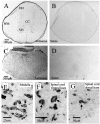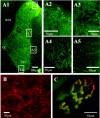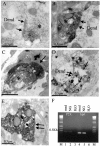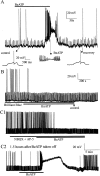Neuronal P2X7 receptors are targeted to presynaptic terminals in the central and peripheral nervous systems
- PMID: 11549725
- PMCID: PMC6762981
- DOI: 10.1523/JNEUROSCI.21-18-07143.2001
Neuronal P2X7 receptors are targeted to presynaptic terminals in the central and peripheral nervous systems
Abstract
The ionotropic ATP receptor subunits P2X(1-6) receptors play important roles in synaptic transmission, yet the P2X(7) receptor has been reported as absent from neurons in the normal adult brain. Here we use RT-PCR to demonstrate that transcripts for the P2X(7) receptor are present in extracts from the medulla oblongata, spinal cord, and nodose ganglion. Using in situ hybridization mRNA encoding, the P2X(7) receptor was detected in numerous neurons throughout the medulla oblongata and spinal cord. Localizing the P2X(7) receptor protein with immunohistochemistry and electron microscopy revealed that it is targeted to presynaptic terminals in the CNS. Anterograde labeling of vagal afferent terminals before immunohistochemistry confirmed the presence of the receptor in excitatory terminals. Pharmacological activation of the receptor in spinal cord slices by addition of 2'- and 3'-O-(4-benzoylbenzoyl)adenosine 5'-triphosphate (BzATP; 30 microm) resulted in glutamate mediated excitation of recorded neurons, blocked by P2X(7) receptor antagonists oxidized ATP (100 microm) and Brilliant Blue G (2 microm). At the neuromuscular junction (NMJ) immunohistochemistry revealed that the P2X(7) receptor was present in motor nerve terminals. Furthermore, motor nerve terminals loaded with the vital dye FM1-43 in isolated NMJ preparations destained after application of BzATP (30 microm). This BzATP evoked destaining is blocked by oxidized ATP (100 microm) and Brilliant Blue G (1 microm). This indicates that activation of the P2X(7) receptor promotes release of vesicular contents from presynaptic terminals. Such a widespread distribution and functional role suggests that the receptor may be involved in the fundamental regulation of synaptic transmission at the presynaptic site.
Figures








References
-
- Afework M, Burnstock G. Distribution of P2X receptors in the rat adrenal gland. Cell Tissue Res. 1999;298:449–456. - PubMed
-
- Armstrong JN, MacVicar BA. P2X7-receptor activation depresses synaptic transmission at hippocampal mossy fiber-CA3 synapses. Soc Neurosci Abstr. 2000;26:884.
-
- Atkinson L, Batten TF, Deuchars J. P2X(2) receptor immunoreactivity in the dorsal vagal complex and area postrema of the rat. Neuroscience. 2000;99:683–696. - PubMed
-
- Ballerini P, Rathbone MP, Di Iorio P, Renzetti A, Giuliani P, D'Alimonte I, Trubiani O, Caciagli F, Ciccarelli R. Rat astroglial P2Z (P2X7) receptors regulate intracellular calcium and purine release. NeuroReport. 1996;7:2533–2537. - PubMed
-
- Bardini M, Lee HY, Burnstock G. Distribution of P2X receptor subtypes in the rat female reproductive tract at late pro-oestrus/early oestrus. Cell Tissue Res. 2000;299:105–113. - PubMed
Publication types
MeSH terms
Substances
Grants and funding
LinkOut - more resources
Full Text Sources
Other Literature Sources
